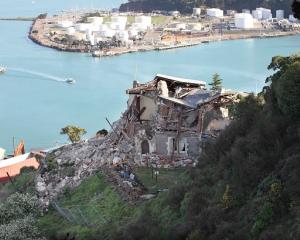
While debate rages over the decision by the Anglican Diocese of Christchurch to demolish the crippled city centre landmark, work will start on the temporary A-frame building in nearby Latimer Square next week.
Constructed with cardboard tubes, timber beams, structural steel, and concrete, it is expected to last 20 years and will become the new place of worship for the city's St John's parish, whose church, vicarage and hall had to be demolished after the February 22 shake.
Richard Gray of the Transitional Cathedral Group described the move as a "symbol of hope for the future'' of the quake-weary city, while being sustainable and affordable.
He said he was confident it would attract tourists to the city.
With seating for 700, the building will also provide a venue for concerts, with the church saying it will host the Christchurch Symphony Orchestra as well as pop stars Dave Dobbyn and Bic Runga.
It will also host exhibitions, civic and community events, which the city has lacked post-February 22.
An ancillary building of linked containers will sit alongside the cathedral and include a café and shop along with meeting rooms, amenities and offices.
The church said today that the capital cost for the new cathedral, as well as supporting buildings, has been estimated at $4m to $5m.
"The bulk of the money is in hand but there will be further fundraising to meet the costs of building the temporary structure,'' Mr Gray said.
A feasibility study was conducted with a $50,000 donation from the Christchurch Earthquake Appeal Trust.
It is the largest `emergency structure' to be designed by Shigeru Ban who, with the support of associate architect Yoshie Narimatsu, has contributed his time free of charge and gifted the building's design to the cathedral, Anglican Diocese and city.
Ban, known as "an emergency architect'' who has built temporary houses in post-disaster centres, including Japan, Turkey, China, Italy, and Haiti said cardboard was the ideal building product for the new cathedral.
"The strength of the building has nothing to do with the strength of the material,'' he said.
"Even concrete buildings can be destroyed by earthquakes very easily. But paper buildings cannot be destroyed by earthquakes.
"It's also consistently low-cost. Normally after disasters the price of building materials goes higher, but since this is not a traditional building material, it's very easy to get.''
The cathedral would be weatherproof, fire resistant and secure, the architect said.
Mr Ban, who had visited the city seven times since last May when the church first adopted the proposal for a "transitional cathedral'', will be in the city this weekend for the first turning of the soil on the site at the corner of Hereford and Madras Streets.
Completion of the build is expected to be sometime in November.
Consumer design magazine Urbis has described the design as "stunning'', sharing the "quiet spirituality and beauty of many other towering stone cathedrals, albeit in a completely different, contemporary, way.''
The church said today that Christchurch architectural firm Warren and Mahoney will soon be commissioned to undertake detailed design which "will allow a more concise costing to be arrived at''.
They say that the cost of the building will be covered in part from their insurances - mainly from a Material Damage indemnity payout, also from Business Interruption contributions.
Extra fundraising will be needed to cover costs related particularly to the annex facility.






